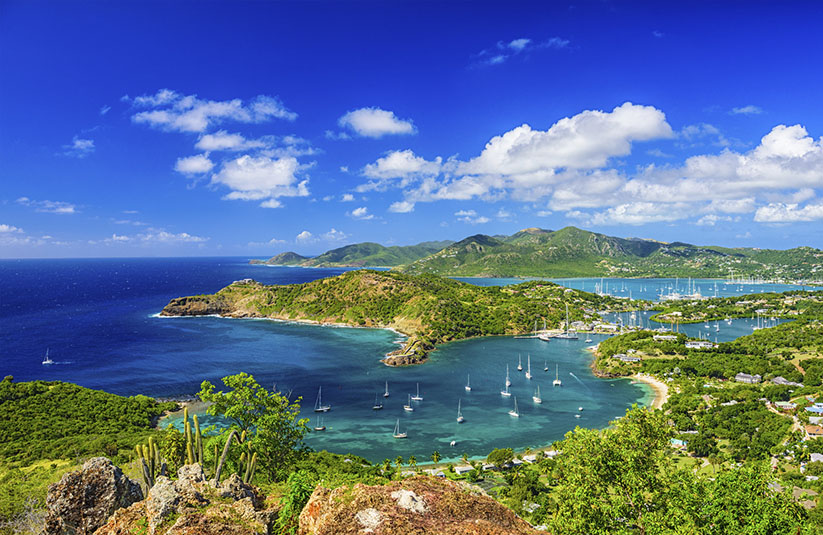
Ready for an adventure involving miles of beaches, perfect weather, and coral reefs — in addition to helping patients in need of your expertise? Then sign up for a locum tenens assignment in the Caribbean. If you’re interested in heading to the tropics, here’s what you need to know about working locum tenens in a variety of Caribbean islands.
A laid-back approach to work and life in the Caribbean
Most of these destinations need locums because they have very small populations from which to recruit physicians. Locums assignments in the Caribbean islands are typically three to six months in length. All of these places are described as having friendly people with a unique, vibrant culture — and a more laid-back approach to both work and life. But they also have less access to healthcare than people in the U.S. The islands need physicians like you to help increase the availability of care, and your presence will be welcome and appreciated.
Dr. Clark Knutson, a pediatrician who has worked several locum assignments in the U.S. Virgin Islands, says that locum tenens doctors in the Caribbean need to be flexible and humble. “You do have to make do. You’ve got to figure out how to work together and how to share. There really is a cooperative atmosphere. It’s very nice to not have turf battles at work all the time; they just go with the flow.”
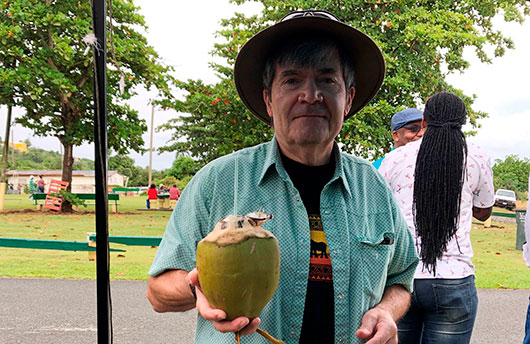
All of the Caribbean islands offer tropical or subtropical weather year-round, gorgeous beaches, delicious food, and opportunities to scuba dive, snorkel, swim, fish, run on the beach, boat, and more. Work/life balance and quality of life are good on the Caribbean islands (think laid back with “easy living”).
Typical locum tenens assignment lengths in the Caribbean
The length of locums assignments in the Caribbean islands vary by location. Locum tenens jobs in the Bahamas and Grand Cayman are 3-6 months in length. Bermuda locum assignments are usually 3-12 months. Jamaica and Puerto Rico ask physicians for a 6-12 month commitment. Barbuda and Antiqua assignments run up to 6 months in length but can be shorter. And the U.S. Virgin Islands can do from as little as 1 week to as much as 3 months.
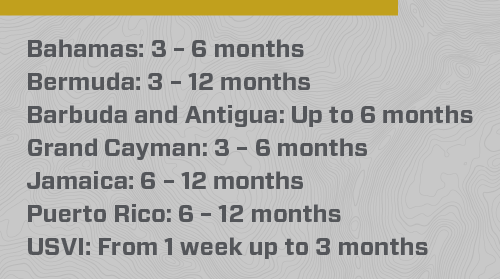
What does life for a locum doctor look like in the Caribbean?
When you work locum tenens jobs in the Caribbean, airfare, housing and transportation, cellphone costs, licensing, registration, and visas are all typically covered while on assignment. Most of the island destinations have a higher cost of living for housing (which is typically covered by your locums contract), food, clothing, and other goods. For instance, the cost of living in Grand Cayman is nearly equal to that of New York City.
All of the Caribbean islands offer tropical or subtropical weather year-round, gorgeous beaches, delicious food, and opportunities to scuba dive, snorkel, swim, fish, run on the beach, boat, and more.
Bahamas
The Bahamas are a 100,000-square-mile archipelago that extends over 500 miles of, what Sailing Directions calls, “the clearest water in the world.” It has 700 islands, including uninhabited cays, and a population of around 300,000.
Healthcare here is considered excellent, with nearly 3 doctors per 1,000 inhabitants (on par with the UK and Finland). “Everyone has access to the facilities found in the three main public hospitals — two in the capital, Nassau, and another in Freeport; plus there are also two private hospitals,” reports Aetna International.
On the other islands, medical provision may not be available seven days a week across the network of clinics, although emergency response teams offer assistance.
Tourist destinations include Nassau — once ruled by pirates — and the desert-like wildlife sanctuary at Inagua. One of the things the Bahamas is noted for is its pink sand beaches, made of microscopic coral insects called Foraminifera that have a bright pink or red shell. One of the best places to enjoy this sand is Harbour Island, which ranks high on many “best beaches in the world” lists. The island is a haven for fishing, diving, and boating, and boasts many unspoiled pink and white sand beaches.
Barbuda and Antigua
Barbuda and Antigua are considered a “twin-island paradise.” Antigua, known as The Land of 365 Beaches, is one of the smallest countries on earth, and Barbuda is not far behind. Collectively, the population of those islands is under 100,000 people.
With 95 miles of coastline, you can expect there to be beautiful white sand beaches, and you’ll be surrounded by one of the richest marine ecosystems in the Lesser Antilles, with dozens of prime snorkeling spots. With an abundance of islets, coral reefs, and shallow waters with the world-renowned Stingray City, you’ll have a different place to snorkel or scuba dive every single day of the year.
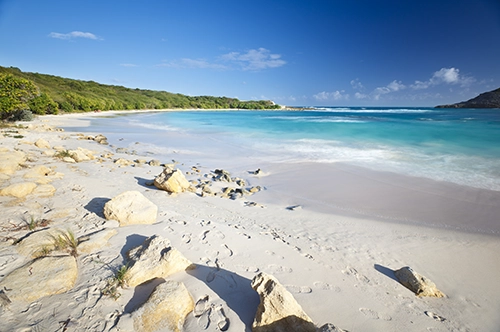
It’s almost impossible to have a poor work/life balance in Barbuda and Antigua, as the locals and expats alike describe life there as “calm, with a real sense of community.” Couple that with the lower cost of living and low taxes, and you’ll find your earnings as a locum physician will go farther, even with the average pay being slightly lower than what physicians earn in the U.S.
As a locum tenens physician on the islands, your airfare, housing and travel, car, cellphone, licensing, registration, and visa are all covered.
Bermuda
Located 600 miles east of the coast of North Carolina, Bermuda isn’t technically in the Caribbean, but it’s often lumped in with the Caribbean Islands because of its tropical climate, island life, and beautiful beaches.
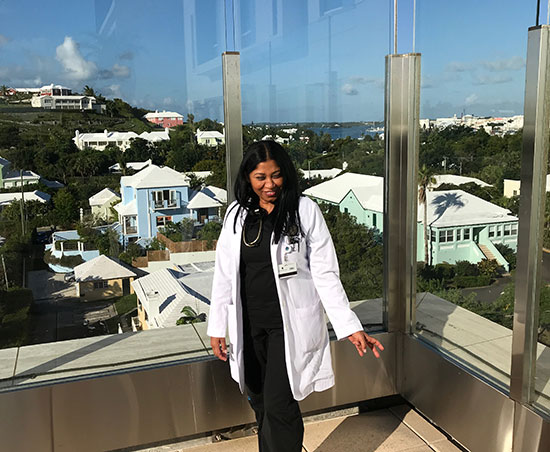
Bermuda is new to using electronic medical records (EMRs). Their first-ever EMR system launched at the end of October 2022, so locum doctors working in Bermuda will no longer have to deal with paper records. Another difference is that doctors do much of the hands-on work — such as starting IVs — instead of relying on the nursing staff. A plus, says hospitalist Dr. Raymattie Singh, who took an assignment in Bermuda, was that she had time to listen to patients.
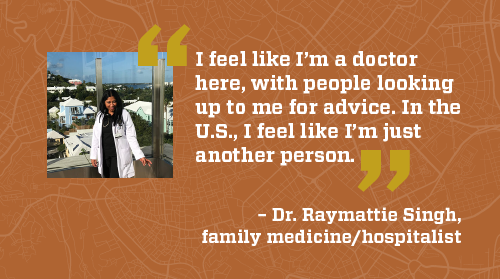
Dr. Singh says that Bermuda’s people are laid-back, calm, and appreciative. “I feel like I’m a doctor here, with people looking up to me for advice. In the U.S., I feel like I’m just another person.”
The best places to see in Bermuda include Horseshoe Bay Beach, a crescent-shaped blush-pink sand beach with dramatic rock formations. It makes PlanetWare’s No. 1 spot for tourists to visit. The town of St. George, with its cobblestone streets and taffy-colored stone buildings, is the oldest English settlement of the New World and a UNESCO World Heritage Site — another must-see.
PlanetWare also recommends the Crystal and Fantasy Caves. There, “you can walk on floating pontoons overlooking crystal-clear, azure waters of the subterranean pools, all lit up with a state-of-the-art lighting system to bring out their natural beauty.”
Grand Cayman
Grand Cayman is south of Cuba and west of Jamaica. It has three well-equipped, advanced hospitals; two of these are privately owned and one is public. Grand Cayman also has family medical practices and many private clinics with specialists of cardiology, endocrinology, gastroenterology, neurology, obstetrics and gynecology, nephrology, pediatrics, and pulmonology. That said, like the other Caribbean locums destinations, it is challenging for the Caribbean hospitals to keep all specialties staffed — and locums should prepare to be flexible and bring a can-do attitude.
In Grand Cayman, spend some time at Cayman Crystal Caves. Another top pick is Stingray City where you can scuba dive into a sea filled with stingrays or observe them up close in a shallow area. Travel Triangle also recommends walking around Queen Elizabeth II Botanic Park, a garden with iguanas, lizards, and orchids.
Jamaica
Locum tenens physicians in Jamaica are needed to support the local doctors and underserved patients, who only have approximately one doctor per 2,000 patients. The island is home to 25 hospitals and 10 private facilities, with primary care being delivered through a network of clinics and regional centers. As a locum physician there, you’ll make slightly less than what you’d earn in the U.S., but with a slower pace of living and a better work/life balance, you’ll reduce your burnout and gain experience in the new, integrated model of care the Ministry of Health and Wellness is adopting.
For doctors on locums assignments in Jamaica, your travel, housing, transportation, licensing, and visa are covered.
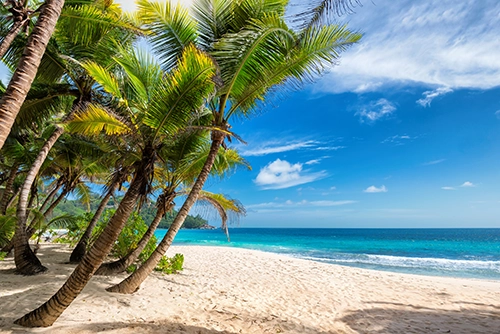
While there, be sure not to miss the Cloud Forest in the Blue Mountains, the island’s rainforests, and Dunn’s River Falls, one of the island’s most famous natural wonders. There’s a rich, vibrant culture in Jamaica, and if you’re a music lover, there’s no shortage of music festivals.
Puerto Rico
Locums doctors in Puerto Rico aren’t required to speak Spanish at the facilities where they’ll be working. Global Medical Staffing will also soon be offering telehealth locums, so you’ll be able to work from the comfort of your own home. The only requirement is to add telehealth in Puerto Rico to any U.S. state license. Locum tenens compensation for physicians in Puerto Rico is typically lower than in the U.S. However, with the slower pace of life, more reasonable workload, a chance to expand your CV, and the opportunity to work with populations in need, you may find that a locums assignment in Puerto Rico is the perfect fit.
Situated between the Dominican Republic and the U.S. Virgin Islands, Puerto Rico is known as “the heart and soul of the Caribbean.” The cost of living is low — one of the lowest in the U.S. states and territories — and that, coupled with a more laid-back style of living, means more time and money to explore Puerto Rico’s 700 miles of coastline.
Despite being a part of the U.S., Puerto Rico has its own rich culture with a blend of indigenous (or Boricua), Spanish, and African traditions. You can watch the parade for la Fiesta de los Reyes Magos over the holidays, or check out local artisans, live music, and a carnival atmosphere during the Festival del Frio on the coldest peak in the mountainous municipality of Adjuntas.
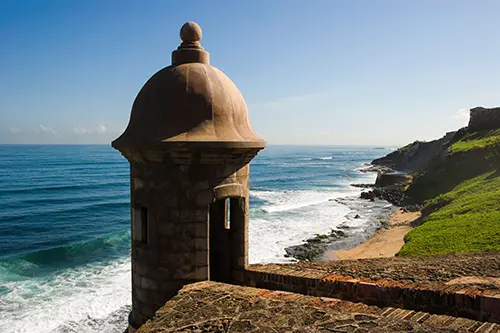
Although English is one of the two official languages, Spanish is predominately spoken throughout the island.
U.S. Virgin Islands
St. Croix, St. John, and St. Thomas make up the U.S. Virgin Islands. The islands are located in the eastern Caribbean, 1,100 miles southeast of Miami, and have an average temperature of 77ºF in winter and 83ºF in summer — as does much of the Caribbean.
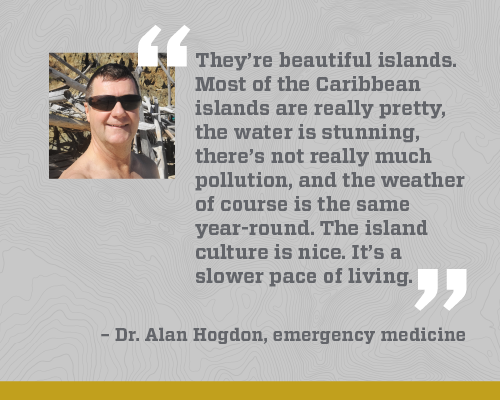
“They’re beautiful islands. Most of the Caribbean islands are really pretty, the water is stunning, there’s not really much pollution, and the weather of course is the same year-round,” says emergency medicine physician Dr. Alan Hogdon. “The island culture is nice. It’s a slower pace of living.”
Pulmonary and critical care physician Dr. Penny Williams says practicing medicine on St. Croix is night and day from her work in the U.S. “The hospital is very poor, they’re not as equipped as hospitals are here, and they have very few specialties. Physicians working assignments here need to have an open mind and be flexible — and patient.”

In the Virgin Islands, malpractice is completely different than on the mainland, says Dr. Marye McCroskey, a family medicine physician who has done locums in the U.S. Virgin Islands and Hawaii. “In the Virgin Islands, physicians have to buy it from the territorial government through their Department of Health. They have considerable tort reform so the limits on it are very, very different than they are on the mainland.”
All of the Virgin Islands, like much of the Caribbean, feature breathtaking beaches with emerald water, secluded coves, pristine coral reefs, and untouched rainforests. You’ll also enjoy scrumptious restaurants, world-class shopping, and exciting festivals.
“The island is absolutely gorgeous,” Dr. Williams says. “The beaches are phenomenal. It’s tropical living and it’s absolutely gorgeous.”
READ HOW: One doctor found work/life balance in the USVI
Consider the Caribbean
“It’s beautiful to live there. The beaches are wonderful. The people are wonderful. They are very friendly and willing to take you right in. They’re gregarious in one-on-one situations. Everyone is very polite. I enjoy taking care of them,” says Dr. Williams. “If you can be flexible, you can enjoy it.”
Interested in learning more about locum tenens jobs in the Caribbean? Give us a call at 1.800.760.3174 or view today’s job opportunities.
Updated January 9, 2024



 Back
Back